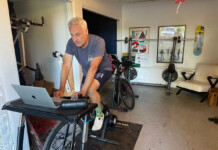Maybe you are familiar with intervals, maybe you have followed a structured interval workout on your trainer over the winter, maybe you have heard your friends talk about doing intervals. In a nutshell, intervals are repeated efforts with recovery between. ‘Intervals’ of work, interspersed with recovery. The reason they work is because with the recovery between, you are able to more consistently hit power or effort targets than just going out and trying to go hard the whole time. (Because you will fade). Riding of any kind will improve your fitness. But we are all strapped for time and doing intervals will be your most efficient use of ride time. Of course, lapping a climb for a set of intervals may not be as interesting as riding a loop with fun, interesting scenery. But you can do that too! Save your looping, adventure/exploration rides for the days you have more time and you will ride at a lower intensity. For time crunched days, try intervals! Here are a few things to keep in mind as you test the interval waters;
- Not all intervals should be at a maximal effort. Depending on the type of intensity required for your goal event(s), the time of year, and your current fitness, you may do intervals at a range of intensities and/or with a range of goals. You may have a goal based on a rate of perceived effort, heart rate, power, cadence, or other objectives.
- Intervals can vary in more than intensity and duration. You will change the training effect by adjusting the amount of recovery between, how hard you start or finish the interval, adding surges, changing cadence, incline, and more.
- As I mentioned, intervals may be targeted around goals other than watts or effort but that is the most common type of interval. For example, you might do a set of four intervals of 10 minutes at tempo power/effort and work your way up to three to four 20 minute intervals of that power/effort. You might do six times two minutes of VO2 power/effort and work your way up to nine times and/or up to four to five minutes. The types, reps, and duration will vary dramatically depending on your current fitness and goals.
- You don’t need a power meter to do intervals but it will allow you to perform the intervals more precisely. Remember that if you train by heart rate zones, your heart rate is a response to an effort. It is your body’s response to how hard you are pedaling. But it doesn’t say anything about objectively how hard you are pedaling (how many watts you are producing). What your response is (your heart rate) can be affected by how tired you are, if you are dehydrated or hungry, if you are hot or cold, if you have had caffeine, if you are tired, and a myriad of other factors. Not to mention heart rate is lagged so will not catch up to your effort for some, even many minutes.
- Based on the above, if you are not training with a power meter, your rate of perceived effort may be a more accurate training metric than heart rate. Most people have little faith in their ability to assess rate of perceived effort but when blinded against a power meter, most of us are pretty good. Think of the rate of perceived effort scale from 1-10 like this:
- Active Recovery: 1-4 (very easy, soft pedaling or not much more)
- Endurance: 4-5 (you can chat but you are starting to work)
- Tempo: 6-7 (hard endurance pace, conversation only in brief phrases between heavy breathing)
- Threshold: 8 (hard, about the max you could sustain for an hour, single word answers, conversation not possible)
- VO2: 9 (hard surges for a several minutes)
- Anaerobic Capacity: 9-10 (just below sprinting)
- Sprinting/Max: 10+
- Don’t overshoot. Start the set of intervals and each individual interval conservatively. The worst way to do an interval is to overshoot and either have to back off or stop completely. Better to be conservative, hold steady, ramp up if you have something left, and finish strong!
These tips give you a beginners idea of training with intervals. For further information or coaching inquiries, please contact me through one of the means below. I’ll see you on my favorite interval hill!
Sarah Kaufmann is the owner of K Cycling Coaching, as well as a professional XC and CX racer based in Salt Lake City, Utah. She can be reached at sarah@kcyclingcoaching.com or 413.522.3180.







